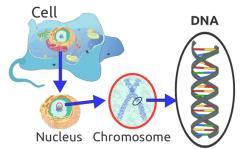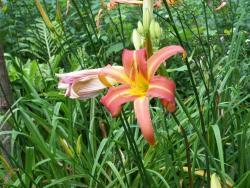Woo Hoooo!!
I finally took the plunge and am reading Chapter 3! Unfortunately, I do have a case of Latineseophobia and Math-perterbashionism – both very painful and debilitating conditions. So, I present only my halting yet happy immersion into the joys of understanding Genetic Principles and Applications. I am sure I will be furiously re-editing as I iron out the kinks that happen during my learning curve in this chapter (itz just the way I like to work!), and will need to revisit at least once or twice for a total overhaul and reworking of my thoughts … but that is all part of the learning process, huh?
*…sprays on some jargon-repellant

and peers through a pair of handy binoculars into the jungle ahead…*
Oh, okay, we are in luck … helpful graphs and some newfangled terminology that they call, I believe, English! Hmmm. Well, here goes then!

Chapter 3 – Make no mistake about it, it's all about Genetic Principles and Applications

(as they were understood by the author at the time this draft was penned in 2009 blah blah so on and so forth and thank goodness I wasn't a PhD student at MIT at that time or I would surely have slowed the group down a bit!).
Okay, still with me? You think I am procrastinating?!?! Huh! Okay, okay fine …. I am starting out slowly to work my way through without getting lost in the forest - and I'm sure you would do the same …

It does appear that there are two ideas about genetics that are helpful landmarks set out for us in this book; at least that's what I saw when I first dared to peek. One idea is that genes, and the way in which their chemical structures and processes work, can be looked at in a functional way (just the way they appear to work in nature) rather than to tackle the perennial frontiers of laboratory tube theory and experimental benchwork. That’s good, because I don’t keep a bunson burner stocked in my kitchen-sink science kit and I appreciate being a benchwarmer until I get the basic lay of a landscape. The other fundamental idea is that those same daylily genes, and the chemicals they produce, cause various colors to appear (or not appear) in the flower.
Alrighty … that wasn’t too painful. I think I’ve heard something similar to these ideas in the news once or twice, maybe even in a classroom or science lab back in the day (yes I did finish high school!) - though - don't ask me to swear to it.

But, uh oh, here comes Concepts and Definitions … I just knew that Latinational terminology would sneak around the corner to devour me into a bottomless pit!

Let’s appraise the damage, then.... Chromosomes … genes … and, uh oh, that word … “sex” !! … and ayah, genotype and phenotype, they reared their heads again too (lessee … pheno is physical, geno is genetical). Huh, two whole pages done and I’m still okay - my friend Merriam Webster didn't have to intervene at all. So, here we go then:
The chapter begins with something pretty familiar – our human chromosomes and genes – so that we can think more easily about a daylily's counterparts and learn things that will be helpful down the road when we get around to dabbing pollen. Humans have 22 different kinds of chromosomes in our cells, with one set of them passed on from each parent (plus one sex chromosome to make a total of 23 kinds from each parent). That means that the total contribution from both parents ends up girding us with 46 chromosomes. Mom and Dad's individual 23 sets pair up together in that classic "X" formation with each other. Likewise, the parents of hemerocallis give a base number of 11 chromosomes each (but sadly, no sex chromosome … or maybe that’s kinda kewl actually, eh?) resulting in a basic diplomat set of 22 in each offspring. Thus, it is Us 46 Versus Them 22. Well, hey, at least we still may hold a slight edge with our complex and subtle human genetic codes - - go humans!!

But, Hah! Another latin word slipped right by us, hemerocallis ("beauty for a day" or so says babelfish).
In both human and beautyforadayallis (oh, gentle pause here, to acknowledge that maybe there is some simplifying principle to dead languages after all) those chromosomes house "spiral ladder" shaped strings that contain thousands of genes that were part of each parent's inheritance. The contribution of these genes is to encode instructions which then define how our physical beings are made and maintained.
Since each and every single plant carries its own unique set of melded genes and chromosomes, then, science has worked out different ways to think about how those hidden genes and chromosomes may match up to, and be responsible for, so many different phenotypical attributes we see, like in our daylily cultivars. By looking at this scientist's approach, we encounter even bigger questions about how we have chosen to define what a plant species actually is, or what is meant by a cross versus a hybrid, since we can observe how the mixing of genes is done in different ways and sometimes with new and differing results. The same thing holds for what is really meant within the hybridizing world – whether we are creating totally new hybrids between species plants, or perhaps are instead breeding new cultivars when we choose line-bred mates to create new generations and forms. Those ideas will be looked at further, and sorted out on our behalf, so that we can follow and grasp the terms that will be used to illustrate the genetics of hemerocallis.
Whew. I don’t know about you, but I am just exhausted from all the worry I had about whether I'd be able to follow the vocabulary and examples in this chapter. What a relief - but, I’ll need to replenish my energy now with some raw carrots before I peer down the barrel of a microscope to see what this all leads to. I suppose I do look forward to the wonder and the magic of this journey, even if it means learning a few more vocabulary words in OkayLatinese, if only to witness the unveiling of the inner workings of daylily cells, bonne home to those mysterious genes and chromosomes.
*munch, munch … *

--> insert wiki media Commons License here for obligatory photo op out of
http://en.wikipedia.org/wiki/C... -- oh click it, it's helpful!



